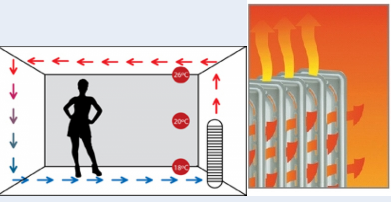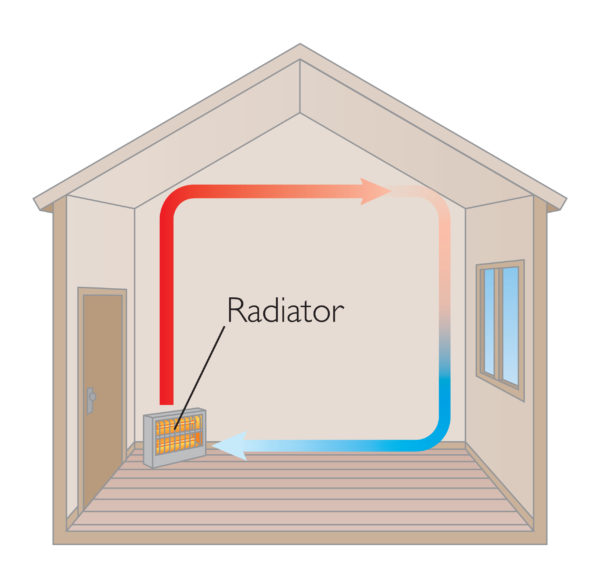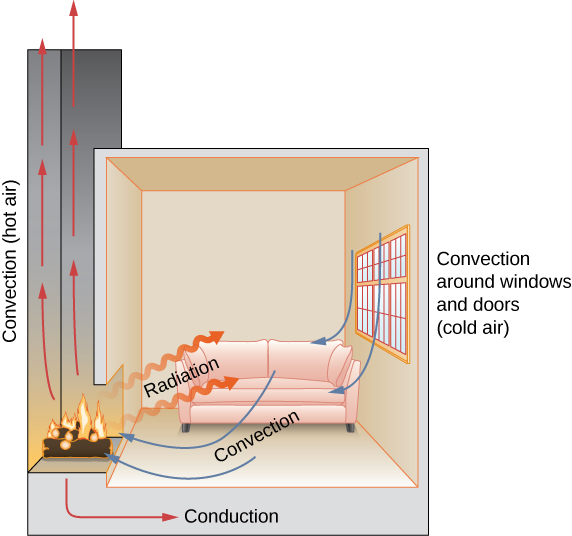How do convection currents work. Your central heating boiler heats water and sends it to the radiators.

What Is The Difference Between A Radiator And A Convector Radiator Energuide
Hot air expands because the particles move further apart as they get hotter see the structure of a gas.

. A radiator follows a nonlinear curve between convection and radiation based on the surface tempwater temp it is supplied with. The result is a convection current that. Heating of a room by a radiator fig.
A radiator warms the air near it which causes this air torise. The colder air above it gets pushed along to the right and then circulates as shown by the arrows. Mixed convectionradiant heaters are typical of heaters used in living rooms and bedrooms.
The transfer of heat from the surface of a heat exchanger to the bulk of a fluid being pumped through the heat exchanger is an example of forced convection. Convection Heat transfer through the movement of a liquid or gas. The convector heater warms the air in contact with it.
Invented in the mid-1800s the concept of radiator heaters has a long history of keeping people warm. In the UK most houses have radiators to heat their rooms. Heat pumps use a compressor to make the working fluid condense at a higher temperatureThe compressor needs input energy.
This current of liquid is called convection current. The pipes lead to radiators that are made of metal. This process repeats until the air in the room is evenly heated.
As we are heating gases in this instance air this process is known as convection. Convection currents then move the air through the room. Heating takes places through a process of convection and conduction by which heat is transferred from the electrical element to the liquid and then from the liquid to the radiator body and metal walls through conduction.
The benefits of using a convection radiator include. The transfer of heat from a hot water radiator to a room is an example of heat transfer by natural convection. As more air is drawn through the bottom and over the fins of the radiator atoms continue to vibrate faster and faster and thermal energy is created.
Or like the radiator in a room that heats up and therefore heats up the whole room. Convection furnaces and radiant heating panels heat large areas but at a much higher cost. The initial heat transfer between the object and the fluid takes place through conduction but the bulk heat transfer happens due to the motion of the fluid.
The hot radiator sets up convection currents that transfer thermal energy to the rest of the room and eventually heat the entire room. A radiator uses convection to heat a room. Alongside provides the process of convection in gasesAir near the radiator is heated and becomes than the air away from the radiator.
Going with a thinner rad and more face surface area increases the radiation. Air that touches the surface is heated and rises forming convection currents. Conversely radiant heating relies on the generation of horizontal waves of heat to warm and keep warm a rooms ambient air thus resulting in a more direct form of heating than convection.
The next heater on our list is the radiator heater an old-fashioned way to keep your family warm. Where air flow is driven by a fan convection heating will take precedence. Describe convection in a room heated by a radiator.
Water is heated and sent through pipes in a room. Convection heat Convection heat is an indirect form of heating. The arrows show how the convection.
Convection occurs when particles with a lot of heat energy in a liquid or gas move and take the place of particles with less heat energy. When the warm air begins to rise it will produce a vacuum-like suction the moves in the cool air that surrounds it. The radiator transfers thermal energy from one place to.
This is the heat transfer we are most interested in. Over the years this type of heater has slowly evolved into the low-maintenance energy-efficient heaters that we know today. The hot air near to the radiator expands and increases in volume.
When the metal walls are heated up they distribute the heat to the air of the room. And practically speaking the advantage of this form of heating over the other is that on the one hand its healthier. This makes the density of the hot air decrease and it starts to rise upwards.
When your radiator is heating up the air its causing atoms to vibrate at a higher frequency. A person can increase or decrease the radiation to convection ratio by sizing the rad to the right specs. The hot radiator warms the.
For instance a hot radiator heats the air immediately around it. Ii Convection in gases-. Radiant panels radiate heat through aluminum panels that absorb heat from heated water or electric cables.
At the same time radiant heat is directed across the room. As the air begins to heat the process continues until all the air in the space is sufficiently heated. This cycle establishes a circular current that stops only when heat is evenly distributed throughout the fluid.
This is a bad name for them - as they give off heat mainly by convection. Floor units radiate heat with sunlight that ceramic tiles plywood or concrete absorb to radiate the heat into the room. The lighter air rises up and replaced the layer of the cool air.
This also sucks in cold air. Convection is the process of heat transfer by the bulk movement of molecules within fluids such as gases and liquids. Despite their drawbacks both convection heating and radiant heating are more effective when used in personal space heaters rather than in large household systems.
Radiator are designed to heat air in the room using CONVECTION to transfer heat from radiator to the surrounding air. The heating element sucks in cold air and then heats it up. This becomes less dense and rises.
The ceiling forces this air to circulate as shown warming the air around it. Electric provides a safer and cleaner alternative to gas. The air rises toward the ceiling pulling cooler air down from the ceiling into the radiator to be heated.
In Open fire heat is transfer by all three View the full answer. Why does a heat pump need an external source of energy. Space heaters use less energy to heat smaller spaces which saves you money in the long term.
Convection is the movement of molecules in fluids andgasses. The heated air rises to the ceiling cools and then drops so that the process can be repeated. As the hot water moves some of the heat energy moves through the walls of the radiator to the air of the room.
Air current close to a radiator. That is the liquid or gas of a certain temperature moves to a new area thus changing the temperature of the new area. An example of convection is a warm radiator.
The space is heated more evenly than with radiated heat.

Natural Convection In Enclosures Lesson 5 Ansys Innovation Courses

0 Comments